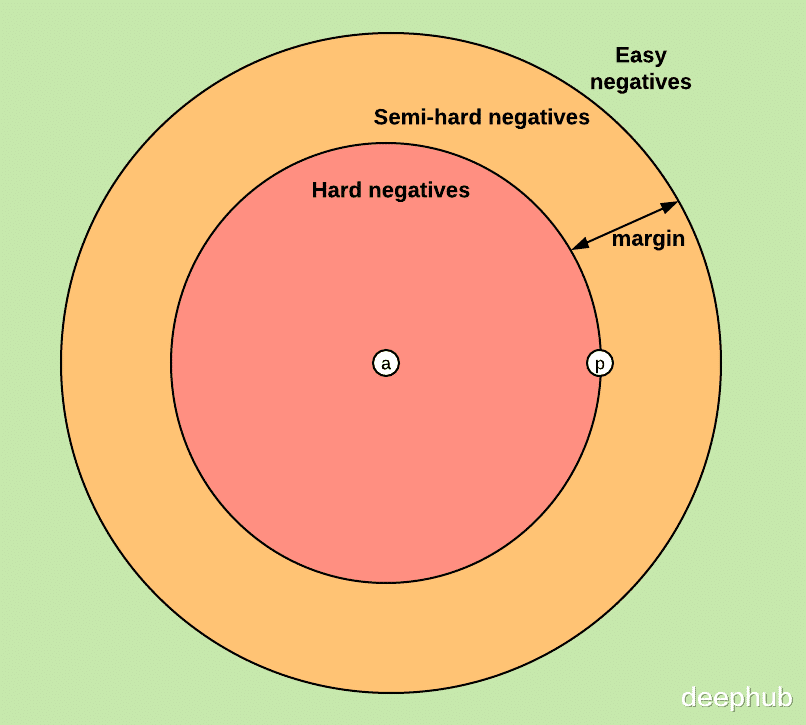本文介绍如何使用 PyTorch 和三元组边缘损失 (Triplet Margin Loss) 微调嵌入模型,并重点阐述实现细节和代码示例。三元组损失是一种对比损失函数,通过缩小锚点与正例间的距离,同时扩大锚点与负例间的距离来优化模型。

一般的嵌入模型都会使用Sentence Transformer ,其中的 encode() 方法可以直接处理文本输入。但是为了进行微调,我们需要采用 Transformer 库,所以就要将文本转换为模型可接受的 token IDs 和 attention masks。Token IDs 代表模型词汇表中的词或字符,attention masks 用于防止模型关注填充 tokens。
本文使用 thenlper/gte-base 模型,需要对应的 tokenizer 对文本进行预处理。该模型基于 BertModel 架构:
BertModel( (embeddings): BertEmbeddings( (word_embeddings): Embedding(30522, 768, padding_idx=0) (position_embeddings): Embedding(512, 768) (token_type_embeddings): Embedding(2, 768) (LayerNorm): LayerNorm((768,), eps=1e-12, elementwise_affine=True) (dropout): Dropout(p=0.1, inplace=False) ) (encoder): BertEncoder( (layer): ModuleList( (0-11): 12 x BertLayer( (attention): BertAttention( (self): BertSdpaSelfAttention( (query): Linear(in_features=768, out_features=768, bias=True) (key): Linear(in_features=768, out_features=768, bias=True) (value): Linear(in_features=768, out_features=768, bias=True) (dropout): Dropout(p=0.1, inplace=False) ) (output): BertSelfOutput( (dense): Linear(in_features=768, out_features=768, bias=True) (LayerNorm): LayerNorm((768,), eps=1e-12, elementwise_affine=True) (dropout): Dropout(p=0.1, inplace=False) ) ) (intermediate): BertIntermediate( (dense): Linear(in_features=768, out_features=3072, bias=True) (intermediate_act_fn): GELUActivation() ) (output): BertOutput( (dense): Linear(in_features=3072, out_features=768, bias=True) (LayerNorm): LayerNorm((768,), eps=1e-12, elementwise_affine=True) (dropout): Dropout(p=0.1, inplace=False) ) ) ) ) (pooler): BertPooler( (dense): Linear(in_features=768, out_features=768, bias=True) (activation): Tanh() ))
利用 Transformers 库的 AutoTokenizer 和 AutoModel 可以简化模型加载过程,无需手动处理底层架构和配置细节。
from transformers import AutoTokenizer, AutoModel from tqdm import tqdm tokenizer = AutoTokenizer.from_pretrained("thenlper/gte-base") # 获取文本并进行标记 train_texts = [df_train.loc[i]['content'] for i in range(df_train.shape[0])] dev_texts = [df_dev.loc[i]['content'] for i in range(df_dev.shape[0])] test_texts = [df_test.loc[i]['content'] for i in range(df_test.shape[0])] train_tokens = [] train_attention_masks = [] dev_tokens = [] dev_attention_masks = [] test_tokens = [] test_attention_masks = [] for sent in tqdm(train_texts): encoding = tokenizer(sent, truncation=True, padding='max_length', return_tensors='pt') train_tokens.append(encoding['input_ids'].squeeze(0)) train_attention_masks.append(encoding['attention_mask'].squeeze(0)) for sent in tqdm(dev_texts): encoding = tokenizer(sent, truncation=True, padding='max_length', return_tensors='pt') dev_tokens.append(encoding['input_ids'].squeeze(0)) dev_attention_masks.append(encoding['attention_mask'].squeeze(0)) for sent in tqdm(test_texts): encoding = tokenizer(sent, truncation=True, padding='max_length', return_tensors='pt') test_tokens.append(encoding['input_ids'].squeeze(0)) test_attention_masks.append(encoding['attention_mask'].squeeze(0))
获取 token IDs 和 attention masks 后,需要将其存储并创建一个自定义的 PyTorch 数据集。
import random from collections import defaultdict import torch from torch.utils.data import Dataset, DataLoader, Sampler, SequentialSampler class CustomTripletDataset(Dataset): def __init__(self, tokens, attention_masks, labels): self.tokens = tokens self.attention_masks = attention_masks self.labels = torch.Tensor(labels) self.label_dict = defaultdict(list) for i in range(len(tokens)): self.label_dict[int(self.labels[i])].append(i) self.unique_classes = list(self.label_dict.keys()) def __len__(self): return len(self.tokens) def __getitem__(self, index): ids = self.tokens[index].to(device) ams = self.attention_masks[index].to(device) y = self.labels[index].to(device) return ids, ams, y
由于采用三元组损失,需要从数据集中采样正例和负例。label_dict 字典用于存储每个类别及其对应的数据索引,方便随机采样。DataLoader 用于加载数据集:
train_loader = DataLoader(train_dataset, batch_sampler=train_batch_sampler)
其中 train_batch_sampler 是自定义的批次采样器:
class CustomBatchSampler(SequentialSampler): def __init__(self, dataset, batch_size): self.dataset = dataset self.batch_size = batch_size self.unique_classes = sorted(dataset.unique_classes) self.label_dict = dataset.label_dict self.num_batches = len(self.dataset) // self.batch_size self.class_size = self.batch_size // 4 def __iter__(self): total_samples_used = 0 weights = np.repeat(1, len(self.unique_classes)) while total_samples_used < len(self.dataset): batch = [] classes = [] for _ in range(4): next_selected_class = self._select_class(weights) while next_selected_class ines: next_selected_class = self._select_class(weights) weights[next_selected_class] += 1 classes.append(next_selected_class) new_choices = self.label_dict[next_selected_class] remaining_samples = list(np.random.choice(new_choices, min(self.class_size, len(new_choices)), replace=False)) batch.extend(remaining_samples) total_samples_used += len(batch) yield batch def _select_class(self, weights): dist = 1/weights dist = dist/np.sum(dist) selected = int(np.random.choice(self.unique_classes, p=dist)) return selected def __len__(self): return self.num_batches
自定义批次采样器控制训练批次的构成,本文的实现确保每个批次包含 4 个类别,每个类别包含 8 个数据点。验证采样器则确保验证集批次在不同 epoch 间保持一致。
模型构建嵌入模型通常基于 Transformer 架构,输出每个 token 的嵌入。为了获得句子嵌入,需要对 token 嵌入进行汇总。常用的方法包括 CLS 池化和平均池化。本文使用的 gte-base 模型采用平均池化,需要从模型输出中提取 token 嵌入并计算平均值。
import torch.nn.functional as F import torch.nn as nn class EmbeddingModel(nn.Module): def __init__(self, base_model): super().__init__() self.base_model = base_model def average_pool(self, last_hidden_states, attention_mask): # 平均 token 嵌入 last_hidden = last_hidden_states.masked_fill(~attention_mask[..., None].bool(), 0.0) return last_hidden.sum(dim=1) / attention_mask.sum(dim=1)[..., None] def forward(self, input_ids, attention_mask): outputs = self.base_model(input_ids=input_ids, attention_mask=attention_mask) last_hidden_state = outputs.last_hidden_state pooled_output = self.average_pool(last_hidden_state, attention_mask) normalized_output = F.normalize(pooled_output, p=2, dim=1) return normalized_output base_model = AutoModel.from_pretrained("thenlper/gte-base") model = EmbeddingModel(base_model)
EmbeddingModel 类封装了 Hugging Face 模型,并实现了平均池化和嵌入归一化。
模型训练训练循环中需要动态计算每个锚点的最难正例和最难负例。
import numpy as np def train(model, train_loader, criterion, optimizer, scheduler): model.train() epoch_train_losses = [] for idx, (ids, attention_masks, labels) in enumerate(train_loader): optimizer.zero_grad() embeddings = model(ids, attention_masks) distance_matrix = torch.cdist(embeddings, embeddings, p=2) # 创建方形距离矩阵 anchors = [] positives = [] negatives = [] for i in range(len(labels)): anchor_label = labels[i].item() anchor_distance = distance_matrix[i] # 锚点与所有其他点之间的距离 # 最难的正例(同一类别中最远的) hardest_positive_idx = (labels == anchor_label).nonzero(as_tuple=True)[0] # 所有同类索引 hardest_positive_idx = hardest_positive_idx[hardest_positive_idx != i] # 排除自己的标签 hardest_positive = hardest_positive_idx[anchor_distance[hardest_positive_idx].argmax()] # 最远同类的标签 # 最难的负例(不同类别中最近的) hardest_negative_idx = (labels != anchor_label).nonzero(as_tuple=True)[0] # 所有不同类索引 hardest_negative = hardest_negative_idx[anchor_distance[hardest_negative_idx].argmin()] # 最近不同类的标签 # 加载选择的 anchors.append(embeddings[i]) positives.append(embeddings[hardest_positive]) negatives.append(embeddings[hardest_negative]) # 将列表转换为张量 anchors = torch.stack(anchors) positives = torch.stack(positives) negatives = torch.stack(negatives) # 计算损失 loss = criterion(anchors, positives, negatives) epoch_train_losses.append(loss.item()) # 反向传播和优化 loss.backward() optimizer.step() # 更新学习率 scheduler.step() return np.mean(epoch_train_losses)
训练过程中使用 torch.cdist() 计算嵌入间的距离矩阵,并根据距离选择最难正例和最难负例。PyTorch 的 TripletMarginLoss 用于计算损失。
结论与讨论实践表明,Batch Hard Triplet Loss 在某些情况下并非最优选择。例如,当正例样本内部差异较大时,强制其嵌入相似可能适得其反。
本文的重点在于 PyTorch 中自定义批次采样和动态距离计算的实现。
对于某些任务,直接在分类任务上微调嵌入模型可能比使用三元组损失更有效。
https://avoid.overfit.cn/post/4b8a8e91f3274f8ca41bfff2a2d60abe
